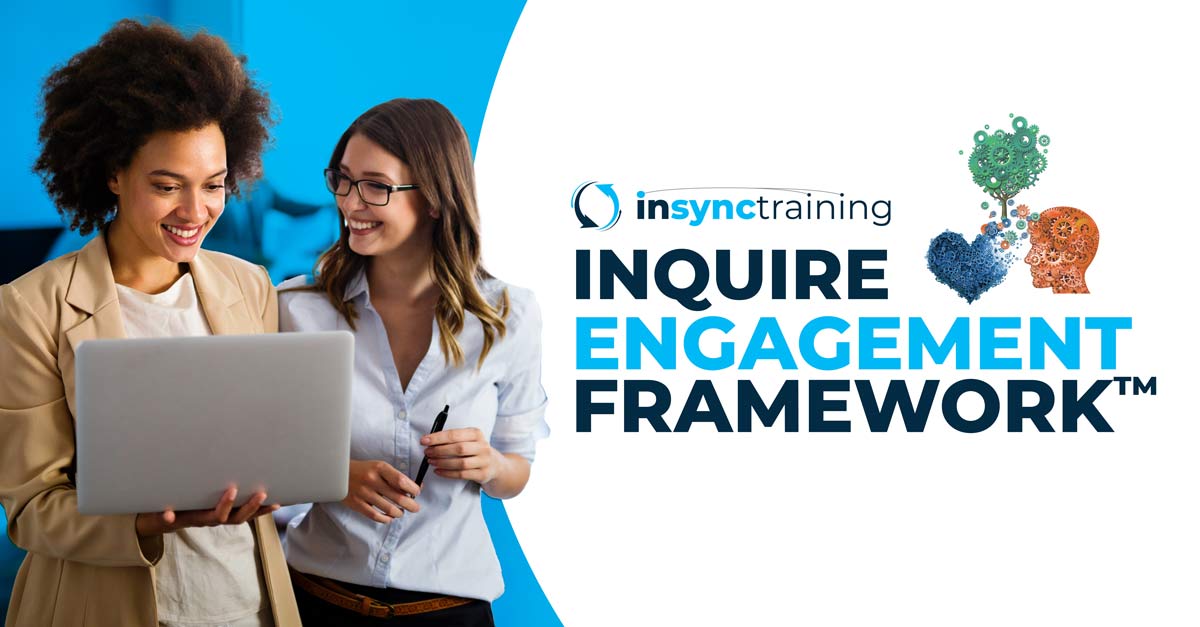4 min read
Engagement Strategies for Virtual, Hybrid, & Blended Learning Environments
.jpg) Dr. Charles (Chip) Dye, Ph.D.
:
Sep 5, 2023 9:00:00 AM
Dr. Charles (Chip) Dye, Ph.D.
:
Sep 5, 2023 9:00:00 AM

Three Dimensions of Learner Engagement: Emotional, Intellectual, and Environmental
InSync Training is continuously conducting research into the dynamics of instruction and the learner experience. Our research effort focuses on developing, refining, and implementing instructional practices that yield measurable improvements in learning outcomes. All that we learn gets translated into the InQuire Engagement Framework™. This framework is structured around three dimensions of learner engagement—emotional, intellectual, and environmental. It includes methods to enhance instructional design and delivery, while aligning them with organizational objectives. As a result, the framework can maximize any learning environment, including those of virtual, hybrid, and blended learning.

Research Findings: The Importance of Engagement
InSync's 2020 research findings offer valuable insights into learner engagement with crucial implications for Learning and Development (L&D) practitioners. The research focused on the learner's experience across various learning environments, revealing that moderate engagement, or scoring above 3.0 on a 5-point scale across the three dimensions, significantly boosts learner performance. In contrast, less-engaged learners displayed stark underperformance. We could qualitatively and quantitatively highlight the vital role of engagement in learning outcomes.
The tangible impacts of these findings are evident in the workplace. For example, engaged learners—those who scored 3.0 or higher on all engagement scales—exhibited an impressive 81% reduction in error rate on job-related tasks after training. This dramatic difference, compared to a mere 23% error reduction for disengaged learners, emphasizes the importance and payoff of maintaining high engagement levels in training programs. From this we know that L&D practitioners operating in hybrid learning, virtual classrooms, and blended learning environments must prioritize engagement as a tool to ensure effective training outcomes.
Implications for Instructional Design
When considering learner engagement within the learning experience, the roles of the instructional designer and instructional team are pivotal in initiating and maintaining engagement throughout the experience. Everything begins with the design.
Key strategic decisions that carry far-reaching consequences in delivery are made in the instructional design and development process. This concept isn't new. However, the impact of poor decisions made early in the design process becomes more evident than ever before in the virtual classroom.
If instructional designers focus on the need to engage learners, what they’re really aiming for is to align the intent of the learner with that of the instruction. Note that this doesn't mean all training must be directly relevant to the profession or professional interests of the learner. Instead, the learner must perceive an alignment of the instruction with their own intent.
In other words, the program teaches what the learner wants to know, and the program is what the learner signed up for. Failure to achieve such alignment significantly reduces the chances of learner engagement and is best characterized as a violation of a basic adult learning principle (Knowles, 1981).
Relevance is perceived by each learner, not an absolute fact. Relevance and applicability under Knowles' andragogical model can be better thought of as a result of aligning individual learner intent with the desired learning outcome.
This alignment can be designed into the training experience. We do it through the development of meaningful activities in a realistic context within a learning environment capable of providing authentic, relevant experiences with the instruction at hand. Such alignment promotes engagement across all three factors to some extent, most notably in the intellectual factor.
Implications for Virtual Classroom Delivery
The instructional delivery team works within the instructional experience to manage interaction between individual learners, lead the instructional experience for learners, promote engagement within the subject matter through discourse and interaction, and manage individual needs within the particular environment. Learner engagement is profoundly dynamic–it’s easy to “lose” a learner if there’s a misstep, intentional or not.
The challenge in a virtual, hybrid, or blended training setting is that missteps are easier to make. Extensive care should be taken to ensure all learners can interact and are provided an opportunity to engage (and prompted, when necessary) with all elements of the learning environment (their peers, the facilitator, and the subject matter being discussed). Sustain a positive perceived relationship between the learner and the desired outcome of the instruction.
The instructional team in a virtual learning environment exercises significant control over engagement factors for learners, with the aim to establish and maintain an environment where learners will engage with the learning experience by optimizing the development of all three factors in each learner.
The InSync team will continue to explore the concept of learner engagement as part of the enhanced InQuire Engagement Framework. In the meantime, read on for some "Do's and Don't's" when it comes to engaging learners in the moment.
The "Do's and Don't's" of Nurturing Emotional Engagement
Nurturing emotional engagement in a virtual classroom is pivotal to individual learner success. Keep these pointers in mind:
Do
-
Uphold respect for all participants and their input.
-
Actively listen and offer personalized feedback.
-
Recognize and acknowledge achievements.
-
Show cultural intelligence and inclusivity for your diverse audience.
-
Foster a psychologically safe learning environment where students feel free to interact.
Don't
-
Disregard feedback or contributions.
-
Overlook the diversity of your learners.
-
Solely depend on verbal interactions, neglecting chat and other subtle cues.
-
Stick rigidly to a script.
-
Force uncomfortable interactions .
The "Do's and Don't's" of Stimulating Intellectual Engagement
When it comes to stimulating intellectual engagement, remember these tips:
Do
-
Leverage collaboration tools to understand learner motivations.
-
Incorporate the experiences of learners for a richer experience.
-
Keep focus and provide opportunities for practice in authentic scenarios.
-
Align the business goal of the program with learner intent.
-
Show how content can be immediately applied in their jobs.
Don't
-
Force participation without explaining why.
-
Ignore lack of completion in blended programs.
-
Favor group participants over individual distance learners.
-
Fail to explain how the training aligns with personal goals.
-
Deliver content that is too basic or advanced.
The "Do's and Don't's" of Fostering Environmental Engagement
Lastly, to foster and sustain environmental engagement, try these:
Do
-
Ensure learner comfort with digital tools.
-
Develop virtual classroom fluency.
-
Set clear interaction and completion rules.
-
Continuously engage learners in their environments.
-
Avoid pointless activities.
Don't
-
Mandate interaction with arbitrary measures.
-
Deliver unequal experiences to the audience.
-
Devalue the virtual classroom experience.
-
Neglect instructional support for individual or group exercises.
Engaging learners is the first step in ensuring learning takes place and business outcomes are met. It can be particularly challenging in virtual, hybrid, and blended environments when we don’t necessarily have the advantages of eye contact and body language. However, the benefits of enhanced outreach and instructional effectiveness (especially considering an evolving workforce) demand excellence in our ability to train in these environments.
What's Next? Design Active & Sustainable Virtual Learning Based on Brain-Science
Learn how to design to maximize learner engagement in hybrid, virtual, and blended learning environments! Register for InSync's Virtual Classroom Design Mastery certificate program and become an expert in fostering engagement and creating dynamic virtual learning experiences.
InSync's InQuire Engagement Framework™, developed by InSync’s Dr. Charles Dye, is based on an operationalized situated cognition model and neuroscience. It optimizes learner trajectory by considering the learner, the learning environment, and the learner-environment interaction through measurable and well-defined measures of effect. To learn more about the original research, and the data on which the framework is based, access the study through the University of Connecticut.

Brain-Science: A Framework for Learner Engagement
The Research behind Our Approach As virtual hybrid learning becomes part of most organizations' learning strategies, many of us have started to...

